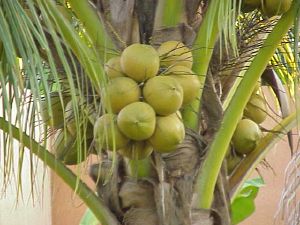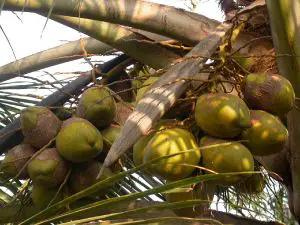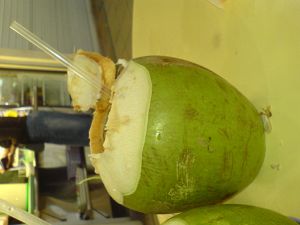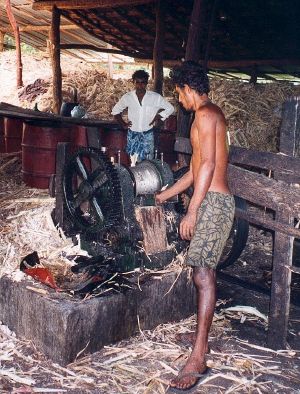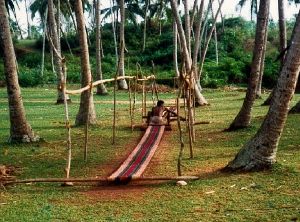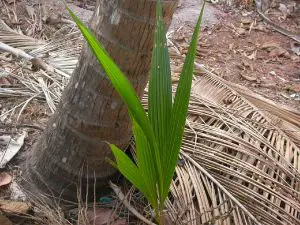Coconut
| Coconut Conservation status: Secure | ||||||||||||||
|---|---|---|---|---|---|---|---|---|---|---|---|---|---|---|
| 240px Coconut Palm | ||||||||||||||
| Scientific classification | ||||||||||||||
| ||||||||||||||
| Binomial name | ||||||||||||||
| Cocos nucifera L. |
The Coconut Palm (Cocos nucifera), is a member of the Family Arecaceae (palm family). It is the only species in the Genus Cocos, and is a large palm, growing to 30 m tall, with pinnate leaves 4-6 m long, pinnae 60-90 cm long; old leaves break away cleanly leaving the trunk smooth. The term coconut refers to the fruit of the coconut palm.
Origins and cultivation
The origins of this plant are the subject of controversy with some authorities claiming it is native to southeast Asia, while others claim its origin is in northwestern South America. Fossil records from New Zealand indicate that small, coconut-like plants grew there as far back 15 million years ago. Even older fossils have been uncovered in Rajasthan & Maharashtra, India. Regardless of its origin, the coconut has spread across much of the tropics, probably aided in many cases by sea-faring peoples. The fruit is light and buoyant and presumably spread significant distances by marine currents: fruits collected from the sea as far north as Norway have been found to be viable (subsequently germinated under the right conditions). In the Hawaiian Islands, the coconut is regarded as a Polynesian introduction, first brought to the Islands by early Polynesian voyagers from their homelands in the South Pacific.
The coconut palm thrives on sandy soils and is highly tolerant of salinity and prefers areas with abundant sunlight and regular rainfall (750 to 2,000 mm annually), which makes colonising shorelines of the tropics relatively straightforward. Coconuts also need high humidity (70–80%+) for optimum growth, which is why they are rarely seen in areas with low humidity (e.g. the Mediterranean), even where temperatures are high enough. They are very hard to establish and grow in dry climates without frequent irrigation.
The flowers of the coconut palm are polygamomonoecious, with both male and female flowers in the same inflorescence. Flowering occurs continuously, with female flowers producing seeds. Coconut palms are believed to be largely cross-pollinated, although some dwarf varieties are self-pollinating.
The fruit
Botanically, a coconut is a simple dry fruit known as a fibrous drupe (not a true nut). The husk (mesocarp) is composed of fibres called coir and there is an inner "stone" (the endocarp). This hard endocarp (the coconut as sold in the shops of non-tropical countries) has three germination pores that are clearly visible on the outside surface once the husk is removed. It is through one of these that the radicle emerges when the embryo germinates. Adhering inside wall of endocarp is the testa with a thick albuminous endosperm, the coconut meat, the white and fleshy edible part of the seed.
When viewed on end, the endocarp and germination pores resemble the face of a monkey, the Portuguese word for which is macaco, sometimes abbreviated to coco, hence the name of the fruit. The specific name nucifera is Latin for nut bearing.
When the coconut is still green, the endosperm inside is thin and tender, a favourite snack. But the main reason to pick the nut at that stage is to drink its juice; a big nut contains up to one litre of refreshing drink. When the nut has ripened and the outer husk has turned brown, a couple of months later, it will fall from the tree of its own accord. At that time the endosperm has thickened and hardened, while the juice has become somewhat bitter.
To open a coconut, remove the outer husk (if not purchased already removed) and pierce two of the three eyes of the fruit (one for the juice to come out of, one to enable air to go in); drain the juice from the fruit. Since coconuts have a naturally-forming fracture point, they can be opened by taking a heavy knife, such as a meat cleaver, and striking the coconut with the flat edge of the knife. Or you can use a flat-bladed screwdriver and a hammer (which is easier, and may be safer than using a cleaver). After inserting the screwdriver slightly, twist it to crack the shell. The coconut should then be turned, and this process repeated until there is a contiguous crack in the shell around the entire fruit. Afterwards, the fruit can be separated at this fracture point. An alternative method is to first drain the juice from the coconut and then place it in an oven at 180 °C for 20 minutes. The heat will crack the shell as well as loosen the flesh, enough so that it will almost fall off.
When the nut is still green the husk is very hard, but green nuts rarely fall, only when they have been attacked by moulds, etc. By the time the nut naturally falls, the husk has become brown, the coir has become dryer and softer, and the nut is less likely to cause damage when it drops. Still there have been instances of coconuts falling from trees and injuring people, and claims of some fatalities. This was the subject of a paper published in 1984 that won the Ig Nobel Prize in 2001. Falling coconut deaths are often used as a comparison to shark attacks, making the claim that it is more likely to be killed by a falling coconut than by a shark. There is no evidence of people being killed in this manner (column from The Straight Dope). However William Wyatt Gill, an early LMS missionary on Mangaia recorded a story in which Kaiara, the concubine of King Tetui, was killed by a falling, green nut. The offending tree was immediately cut down. This was around 1777, the time of Captain Cook's visit.
In some parts of the world, trained monkeys are used to harvest coconuts. Training schools for monkeys still exist in southern Thailand. Competitions are held each year to discover the fastest harvester.
Uses
All parts of the coconut palm are useful, and the trees have a comparatively high yield (up to 75 fruits per year); it therefore has significant economic value. The name for the coconut palm in Sanskrit is kalpa vriksha, which translates as "the tree which provides all the necessities of life". In Malay, the coconut is known as pokok seribu guna, "the tree of a thousand uses". In the Philippines, the coconut is commonly given the title "Tree of Life".
Uses of the various parts of the palm include:
- The white, fleshy part of the seed is edible and used fresh or dried in cooking.
- The cavity is filled with "coconut water" containing sugars, fibre, proteins, anti-oxidants, vitamins and minerals, which provide excellent isotonic electrolyte balance, and an exceptional nutritional food source, which is why it is used as a refreshing drink throughout the humid tropics. It is also used in the making of the gelatinous dessert nata de coco. Mature fruits have significantly less liquid than young immature coconuts. Coconut water is sterile until the coconut is opened (unless the coconut is spoiled).
- Sport fruits are also harvested, primarily in the Philippines, where they are known as macapuno.
- Coconut milk (which is approximately 17% fat) is made by processing grated coconut with hot water or hot milk which extracts the oil and aromatic compounds from the fibre, and should not be confused with the juice found naturally in young coconuts, called coconut water or coconut juice.
- Coconut cream is what rises to the top when coconut milk is refrigerated and left to set.
- The leftover fibre from coconut milk production is used as livestock feed.
- The sap derived from incising the flower clusters of the coconut is fermented to produce palm wine, also known as "toddy" or, in the Philippines, tuba.
- Apical buds of adult plants are edible and are known as "palm-cabbage" (though harvest of this kills the tree).
- The interior of the growing tip may be harvested as heart-of-palm and is considered a rare delicacy. Harvesting this also kills the tree. Hearts of palm are often eaten in salads; such a salad is sometimes called "millionaire's salad".
- The coir (the fibre from the husk of the coconut) is used in ropes, mats, brushes, caulking boats and as stuffing fibre; it is also used extensively in horticulture for making potting compost.
- Copra is the dried meat of the seed which is the source of coconut oil.
- The leaves provide materials for baskets and roofing thatch.
- The husk and shells can be used for fuel and are a good source of charcoal.
- Hawaiians hollowed the trunk to form a drum, a container, or even small canoes.
- The wood can be used for specialized construction (notably in Manila's Coconut Palace).
- The stiff leaflet midribs make cooking skewers, kindling arrows, or bound into bundles, brooms and brushes.
- The roots are used as a dye, a mouthwash, or a medicine for dysentery. A frayed-out piece of root makes a poor man's toothbrush.
- Half coconut shells are used in theatre, banged together to create the sound effect of a horse's hoofbeats. They were also used in this way in the Monty Python film Monty Python and the Holy Grail.
- Dried half coconut shells are used to buff floors.
- In fairgrounds, a "coconut shy" is a popular target practice game, and coconuts are commonly given as prizes.
- A coconut can be hollowed out and used as a home for a rodent or small bird.
- Coconut water can be used as an intravenous fluid (see PMID 10674546).
- Fresh inner coconut husk can also be rubbed on the lens of snorkling goggles to prevent fogging during use
- Dried half coconut shells are used as the bodies of musical instruments, including the Chinese yehu and banhu, and the Vietnamese đàn gáo.
- Coconut is also commonly used as a herbal remedy in Pakistan to treat bites from rats.
Cultural aspects
Coconuts are extensively used in Hindu religious rites. Coconuts are usually offered to the gods, and a coconut is smashed on the ground or on some object as part of an initiation or inauguration of building projects, facility, ship, etc.; this act signifies sacrificing ego, that wealth stems from divinity, and if due credit is not given, bad karma is taken on.
The Indonesian tale of Hainuwele tells a story of the introduction of coconuts to Seram.
The people of the state of Kerala in southern India consider Kerala to be the "Land of Coconuts", nalikerathinte nattil.
The word "coconut" is also used as a mild derogatory slang word referring to a person of Latino or Indian subcontinent descent who emulates a Caucasian (brown on the outside, white on the inside).
"Coconut" is Australian slang for a Tongan, or other person of "Polynesian" descent, although usually not Maori.
"Coconut" is also the title of a song by Harry Nilsson.
"Coconut" is also the title of an In Reverie b-side track by Saves the day.
- Cocos nucifera2.jpg
- Koeh-188.jpg
19th century illustration of the flowers
External links
- Coconut Research Center
- Kokonut Pacific Developers of Direct Micro Expelling (DME) technology that enables Islanders to produce pure cold-pressed virgin coconut oil
- Coconut Festival
- Coconut Time Line
- Plant Cultures: botany, history and uses of the coconut
- Purdue University crop pages: Cocos nucifera
Credits
New World Encyclopedia writers and editors rewrote and completed the Wikipedia article in accordance with New World Encyclopedia standards. This article abides by terms of the Creative Commons CC-by-sa 3.0 License (CC-by-sa), which may be used and disseminated with proper attribution. Credit is due under the terms of this license that can reference both the New World Encyclopedia contributors and the selfless volunteer contributors of the Wikimedia Foundation. To cite this article click here for a list of acceptable citing formats.The history of earlier contributions by wikipedians is accessible to researchers here:
The history of this article since it was imported to New World Encyclopedia:
Note: Some restrictions may apply to use of individual images which are separately licensed.

